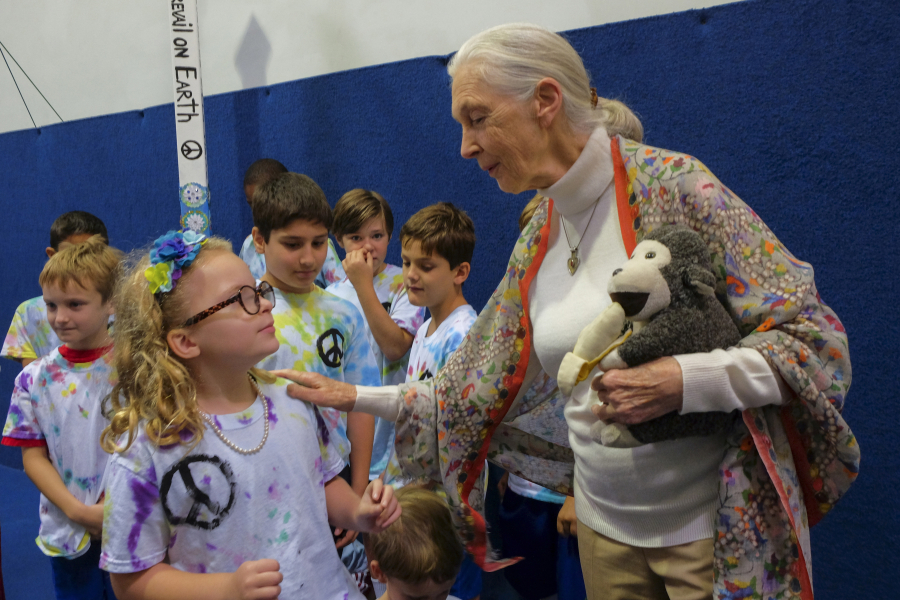The children knew a lot about Jane Goodall’s life before she walked through the front door of their Northern Virginia school on Tuesday morning. They had been studying her.
They knew she had been a curious girl who grew up in England loving animals, and that she had gone off to Africa and spent decades living with chimpanzees in the wild. They knew that her observations sent shock waves through the world of science, forcing humans to recognize how much we have in common with apes. And they knew that she is now a crusader for conservation, working to persuade people to take care of animals, each other and the Earth.
But there was something they hadn’t quite grasped until she was there, standing before them: Jane Goodall — and her incredible story — are real.
“I touched her,” said incredulous 7-year-old Lillian Sayer.
“She’s really cool,” said Vivienne Mestraud, 9. “I hope when I grow up I can be an animal activist as well, and I can save animals too.”
They were two of about 75 students at the private Newton School in Sterling who had the chance, with their parents and teachers, to hear Goodall speak Tuesday.
Goodall, 82, travels 300 days a year to share the stories she has lived during the past half-century with audiences around the world. It can be exhausting, she said. But she wants to inspire people — especially children — not just to care about dwindling forests, declining chimp populations and the abject conditions in which so many people live, but to persuade them to do something. To show them that their actions matter.
“The only way I’ve found to change people’s minds is to tell them stories,” Goodall said in her soft British lilt.
She told a tale about a chimpanzee who was taken from the forest to a laboratory, where he became a subject of medical testing. Despite suffering at the hands of humans, he befriended his caretaker and then saved that man’s life when it was threatened by other chimps.
Goodall described the life of another young chimp, Wounda, whose mother was illegally shot and killed for her meat. Wounda was nursed back to health at one of several rehabilitation centers run by the Jane Goodall Institute, the Vienna, Va.-based conservation organization that Goodall started in 1977.
Goodall met Wounda on the day she was released onto one of the institute’s wild island sanctuaries. The animal paused and, in a moment caught on film, turned to Goodall and embraced her — as if she knew that Goodall had made this possible, as if to say thank you before disappearing into the forest.
“It was one of the most amazing things that’s ever happened to me,” Goodall said.
She was a 26-year-old secretary with no university training when she moved to the forest of what is now Tanzania, sent there by the preeminent paleoanthropologist Louis Leakey to observe chimp behavior. It was a way to find clues, Leakey reasoned, about the lives and behaviors of our earliest human ancestors.
Not long after arriving, Goodall saw something astonishing. A chimp she called David Greybeard broke off a piece of grass and dipped it into a termite mound. When he pulled the grass out, it was covered in termites, which he promptly ate.
She had seen an ape using a tool, something scientists believed only people could do. Her discovery forced scientists to redefine what it means to be human, the first of many observations that blurred lines that had previously seemed clear. “The longer I was there, the more like us I saw that they were,” Goodall said.
Goodall named the chimps she lived with, and she saw that — like her childhood pet dog — chimps had emotions and personalities. They had the capacity to feel sad and happy, to feel joy and pain, to show affection and to attack one another.
It was all scientific heresy at the time. But Goodall’s observations of chimpanzees in east Africa paved the way for a revolution in the way we think about animals, and it is now common for scientists to study animals’ personalities and social lives.
Now that we have so much evidence that animals can feel emotions, Goodall told students Tuesday, how can we not do something to help those who are in pain? How can we not do a better job caring for the habitats on which those animals depend?
“Don’t you think it’s peculiar that with this clever brain we have, that we’re harming the planet so much?” she asked the students. She said she draws energy from hearing what children are doing to make a difference all over the world.
“It’s what keeps me going,” she said.



